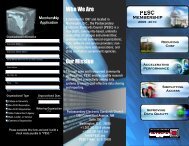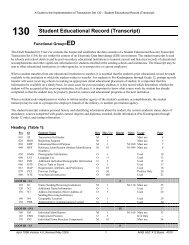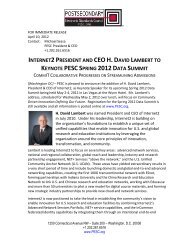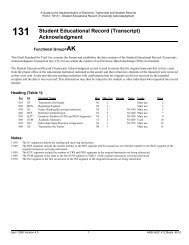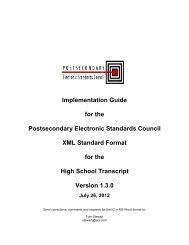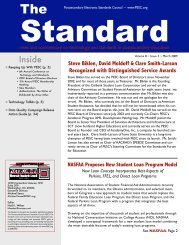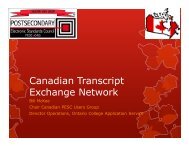February 2013 - PESC
February 2013 - PESC
February 2013 - PESC
Create successful ePaper yourself
Turn your PDF publications into a flip-book with our unique Google optimized e-Paper software.
2012 Survey of Chief Information Officers<br />
5<br />
Stretching IT Funding<br />
Among the new questions on the survey this year was,<br />
“What strategies are being considered for stretching<br />
IT funding?” Institutions were asked to select all the<br />
strategies that applied. On the top of the list was<br />
delayed maintenance or replacement selected by 80%<br />
of respondents, while 73% selected shared services/<br />
collaboration with other institutions as a means of<br />
stretching IT funding. Next on the list was a greater<br />
use of open source selected by 52% of institutions,<br />
followed by cutting services (41%), and other new<br />
revenue selected by 35%.<br />
Delayed maintenance and replacements are still being<br />
utilized to stretch available budgets, but this strategy will<br />
hit home in the next few years as the backlog of work<br />
and failure of old technologies come home to roost.<br />
This problem was highlighted in the book The Decaying<br />
American Campus: A Ticking Time Bomb, published by<br />
APPA (The Association for Leadership in Educational<br />
Facilities) and NACUBO (the National Association of<br />
College and University Business Officers) in 1989. At<br />
some point, the cost for deferred maintenance exceeds<br />
the cost of continual renewal and replacements. CIOs<br />
must be careful not to press too hard on short-term<br />
budget savings, which will ultimately cost the institution<br />
more in the long run while increasing customer<br />
frustrations.<br />
Strategies Being Considered to Stretch IT Funding<br />
Other new revenue streams including increased fees,<br />
selling services<br />
35.3%<br />
Cutting services<br />
Greater use of Open Source<br />
Shared services/collaboration with other institutions<br />
72.9%<br />
No new strategies<br />
40.6%<br />
51.2%<br />
7.2%<br />
IT Organization<br />
and Governance<br />
CIOs face unique challenges created in part by the<br />
institutional governance structures and the unpredictable<br />
financial environments of the past few years. Recent<br />
budget fluctuations are influencing the workforce<br />
as well as decisions to outsource certain services.<br />
Institutions are not increasing their use of student<br />
workers and have been less consistent in retaining or<br />
growing full-time staffing levels. Outsourcing and cloud<br />
computing continue to grow, but there is a dichotomy<br />
in the type and level of institution that is satisfied with<br />
these options. Those institutions—which were already<br />
outsourcing networking, administrative applications,<br />
and lab maintenance/support or project management—<br />
were also very likely to consider moving their e-mail and<br />
social networking to the cloud. University CIOs regularly<br />
find themselves at the nexus of numerous institutional<br />
discussions and decisions, many of which are becoming<br />
more strategic in nature and include topics that are not<br />
normally seen in the CIO purview.<br />
University leaders increasingly look to CIOs to provide<br />
leadership and expertise in IT services, but the CIO<br />
also must be savvy in a larger spectrum of institutional<br />
knowledge and skills reserved for other business units.<br />
Business process improvement and strategic planning at<br />
the institutional level lead the way for the CIO to provide<br />
the most value. The level of educational attainment and<br />
the business maturity of the person in the CIO role often<br />
influence the reporting hierarchy. CIOs are relying more<br />
on IT governance models to aid in the decision making<br />
and to involve business unit leaders in best applying<br />
IT solutions to business problems. These governance<br />
committees are tending to include higher-level university<br />
leaders, board members, and even external advisers.<br />
Although CIOs consider this input to be very important,<br />
the majority still say that the final IT decision should<br />
be theirs.<br />
Staffing<br />
CIO staffing patterns have changed since the 2010<br />
survey. For the past two years, the CIOs reported full-time<br />
staff numbers moving from flat to the more extremes.<br />
Depending on the institution, almost one-third either<br />
reduced or added to their staffs. This differs from 2010,







